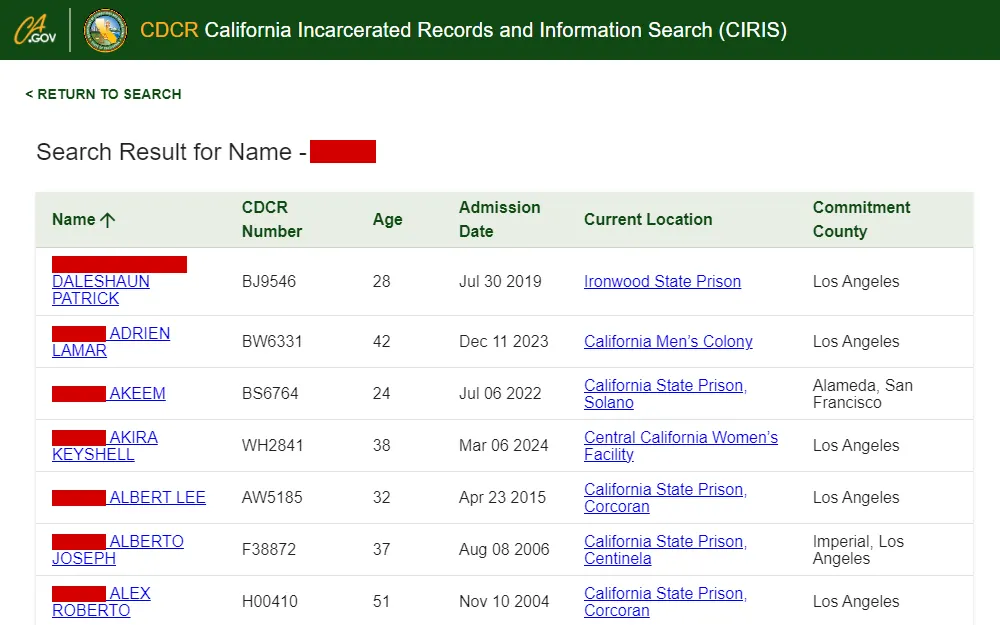Run a free California probation search today to obtain important information. Probation and parole are both legal alternatives to incarceration, offering individuals a chance to reintegrate into society while under supervision.
Probation is sometimes granted in place of or in addition to incarceration, usually as part of an individual’s sentence. Parole is a condition of release from prison for those who have served part of their sentence and been deemed safe to rejoin society (usually with conditions).
This resource provides guidance on performing a probation search and finding parole information for Californians.
How To Execute a California Probation Search for Free
For information about a non-incarcerated individual, conduct a public records search with the Department of Justice. You can make this type of request by visiting the California Department of Corrections and Rehabilitation (CDCR) Public Records Portal and entering information about the offender.
To use this service, click on Submit Request from the website’s homepage. From there, choose Public Records Act Request for general data held by the CDCR.
You can also do a Research Request, if you want to conduct your research with CDCR.1 Both options require you to create an account, which involves providing your basic contact information.
When requesting public records while doing a probation search, it’s important to direct your request to the public records coordinator in the area where you believe the records are held.
It’s strongly encouraged to make requests in writing and to include as many details about the person as possible. Remember, not all records or information is accessible, so focus on a particular court case and its disposition to yield the best results when determining probation status for an individual.
Under California’s Public Records Act and the state’s constitution, the public has a right to access public information maintained by state and local governments, and this includes the California Department of Justice information.2, 3
To check California probation information and an offender’s status for free, a good jumping off point is the CDCR website. This website offers an online offender search tool CIRIS, which stands for California Incarcerated Records and Information Search.4 Keep in mind that this tool only lists information and probation/parole status for currently incarcerated individuals.
To use CIRIS, click on the appropriate link from the CDCR website’s homepage and agree to the terms of conditions of use. Choose whether to search by the individual’s name or CDCR number, then click on Search. You can narrow the results received by also including an age range or commitment county if known.

The offender search tool returns results based on the information provided. Click on an inmate’s name to learn more about the offender’s probation status.
Conduct a Search for Probation Records via County & Municipal Agencies in CA
It is sometimes possible to find probation information for a specific offender by searching for details of the criminal case where the person was charged and how the case was finalized by the courts.
Los Angeles County: The Los Angeles Superior Court offers a number of useful databases and search tools, including an online portal. The record is searchable by the offender’s name or you can review the summary of a case by using the case number.

Please note that you can use the portal as a guest or create an account. However, there is a nominal fee (based on a sliding scale) for accessing the portal’s records.7
Optionally, find case dispensation details, including California probation status information, for an individual in a criminal case by visiting the Los Angeles County courthouse in person and requesting the public records. You can also access or obtain additional record types (such as arrests, criminal histories, vital records, and more) by following the guidance of the Los Angeles County free public information search tutorial.
San Diego County: Court case records are held by the San Diego Superior Court and may be accessible on the court’s website. From the website’s homepage, click on Access Court Records, and then Online Case Search – Court Index. Search by the person’s name or case number, if known.
Enter as much information about the offender as possible, including the case type, case location, party type and year filed. Once you have located the offender, you can access any files that are imaged in the database.

If only the case number is available, you may need to visit the courthouse to find the information you need. Under the California Rules of Court, the public is entitled to inspect all papers in the court’s files, provided that the records are not legally sealed.9 Visit the San Diego County courthouse public records department and provide the case number to inspect unsealed documents related to the case.
Orange County: Criminal cases are recorded by the Orange County Superior Court. The website for the court offers an online case search tool.
From the homepage, click on Online Case Access, look for Criminal & Traffic Cases, and then click Access Now. Search by case number without creating an account, or create an account to search records by the person’s name. There is a fee of $1.50 per online name search, with a discount if credits for multiple searches are purchased in advance.10
Riverside County: To determine the disposition of a criminal case, visit the official website of the Riverside County Superior Court. From the homepage, click on Search Court Records, and then click Search Criminal Records. To search by name, you must create an account, and there is a fee for name searches.11
Case records generally include the charge, court dates and the case’s disposition, indicating the current status of the case or its outcome. If the offender was granted probation, those details are included. Alternatively, you can visit the Riverside County courthouse where the case was heard to inspect documents in person.
San Bernardino County: Criminal case records can be accessed by visiting the website of the San Bernardino Superior Court. From the homepage, click on Access Court Information, then accept the terms and conditions for using the Court Access Portal.

Registration is required. Once registered, you can perform a search by case number or party. Visiting the Superior Court of California County of San Bernardino or contacting the county clerk are alternative methods of obtaining case disposition details that may be helpful when performing a probation search. There may be a fee payable for searches, and if the fee applies, requestors will be informed before the search begins.13
How To Look Up Probation Violations & Supervising Officer Contact Details in California
Probation violations and other related records are often confidential, other than information obtained from court documents for related cases involving the violation. However, it is possible to reach out to the relevant department in the county where the case was heard and/or disposed of as part of conducting a probation search.
In most cases, a visit to the county’s probation website, if applicable, is the best place to find contact information for probation officials in that particular county.
The Board of State & Community Corrections oversees issues relation to correctional facilities and probation.14 The board can be contacted at the following address:
Board of State & Community Corrections
2590 Venture Oaks Way, Suite 200
Sacramento, CA 95833
Telephone: 916-445-5-73
Email: [email protected]
Each county has at least one adult probation office. Larger counties, such as Orange County, have two:
The Santa Ana office can be reached at:
OC Probation
Santa Ana Office
900 N. Main Street
Santa Ana, CA 92701
Telephone: 714-569-2000
The North County Field Services Office can be reached at:
OC Probation
North County Field Services Office
1535 E. Orangewood Avenue,
Anaheim, CA 92805
Telephone 714-937-4500
How To View Details of Any Parolee in California
Due to privacy concerns, getting information on parolees throughout California can be challenging if you don’t know where to look.
Parole differs from probation in that it’s offered to people who have served some time in prison, giving them the chance to serve the remainder of their sentence in the community. Probation is offered for lesser offenses instead of a custodial sentence. Information about parole is a matter of public record.
The California Department of Corrections & Rehabilitation (CDCR) website includes a wealth of information about current inmates and their location and status.4 This website offers an online offender search tool, CIRIS, which lists information about incarcerated individuals and those who are on release in the community.
CIRIS can be used with as little information as a surname, but having a first name and/or an approximate age helps narrow down the search. There is no fee for using this tool.
If the online search does not bring up the expected result, interested parties can contact CDCR’s Identification Unit at (916)445-6713. The helpline is open Monday through Friday from 8:00 a.m. to 4:30 p.m. excluding state holidays.
Using the above public records sources, it’s possible to find a wealth of information about inmates and conduct a California probation search for free or for a nominal fee.
You can also dig deeper into residents throughout the state using the California free public record search instructions (for guidance on finding records of divorces, marriages, court cases, and more) as well as the steps for looking up CA criminal and arrest details.
References
1California Department of Corrections and Rehabilitation. (n.d.). Research Requests. Retrieved March 11, 2024, from <https://www.cdcr.ca.gov/research/research-requests/>
2California Attorney General’s Office. (2004, August). Summary of the California Public Records Act 2004. Retrieved March 11, 2024, from <https://www.ucop.edu/uc-legal/_files/access-privacy/summary_public_records_act.pdf>
3California State Legislature. (2023, May). The Constitutions of California and the United States. Retrieved March 11, 2024, from <https://www.senate.ca.gov/sites/senate.ca.gov/files/2023-24_constitution_final_wcover.pdf>
4California Department of Corrections and Rehabilitation. (n.d.). CDCR California Incarcerated Records and Information Search (CIRIS). Retrieved March 11, 2024, from <https://apps.cdcr.ca.gov/ciris/search>
5California Department of Corrections and Rehabilitation. (2024). Search Result for Name. CDCR California Incarcerated Records and Information Search (CIRIS). Retrieved March 11, 2024, from <https://apps.cdcr.ca.gov/ciris/results?lastName=smith>
6Los Angeles County Superior Court. (2024). Search for Case by Defendant Name. Retrieved March 11, 2024, from <https://www.lacourt.org/paos/v2Public/CriminalIndex/Search>
7Los Angeles County Superior Court. (n.d.). Fee Information. Retrieved March 11, 2024, from <https://www.lacourt.org/paos/v2/FeeInformation>
8San Diego County Superior Court. (n.d.). Party Name Search. Retrieved March 11, 2024, from <https://courtindex.sdcourt.ca.gov/CISPublic/namesearch>
9Judicial Council of California. (2024, January 1). Rules of Court. Retrieved March 11, 2024, from <https://www.courts.ca.gov/rules.htm>
10Orange County Superior Court. (2024, January 1). Orange County Civil Fee Schedule. Retrieved March 11, 2024, from <https://www.occourts.org/system/files/general/ocfeeschedule.pdf>
11Riverside County Superior Court. (2023, December 27). Riverside Fee Schedule. Retrieved March 11, 2024, from <https://www.riverside.courts.ca.gov/system/files/general/feeschedule.pdf>
12San Bernardino County Superior Court. (n.d.). Court Access Portal. Retrieved March 11, 2024, from <https://cap.sb-court.org/search>
13San Bernardino County Superior Court. (n.d.). Administrative Records Request. Retrieved March 11, 2024, from <https://www.sb-court.org/forms-and-rules/administrative-records-request>
14California Board of State and Community Corrections. (n.d.). About the Board of State and Community Corrections. Retrieved March 11, 2024, from <https://www.bscc.ca.gov/m_bsccboard/>
